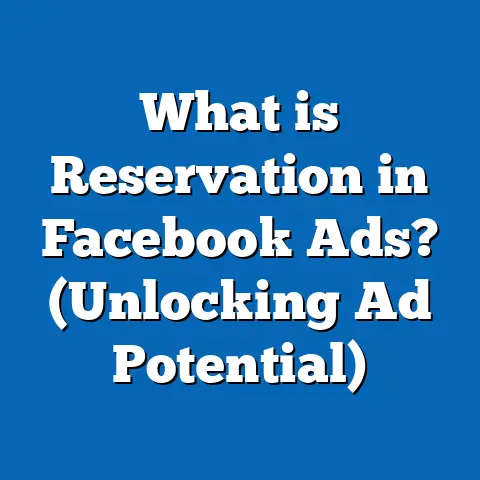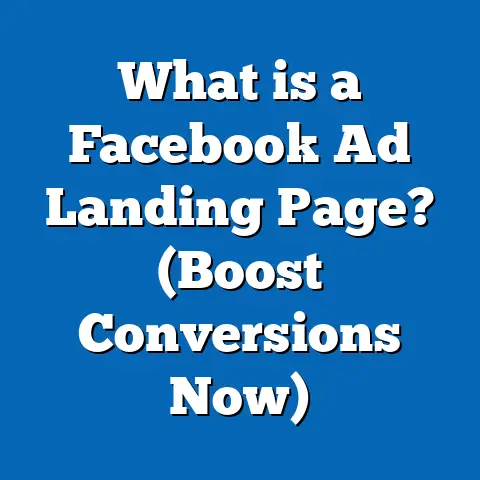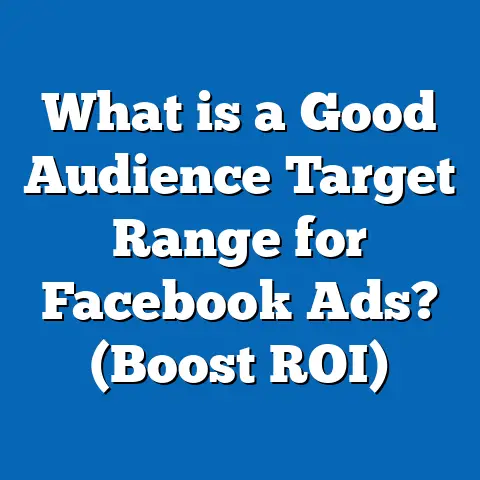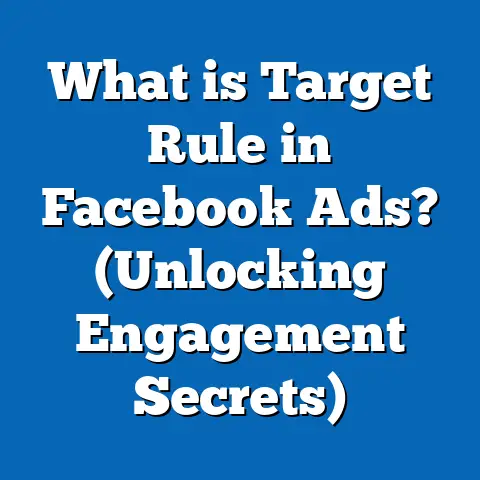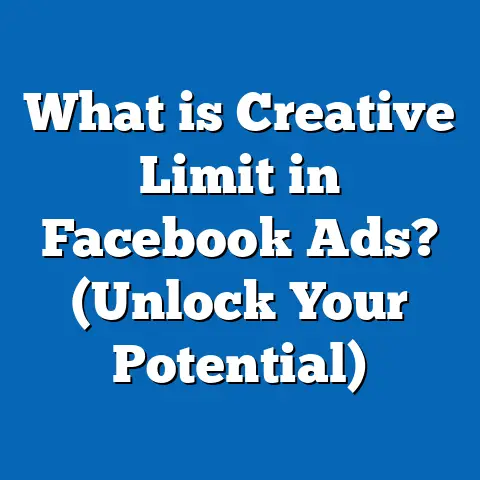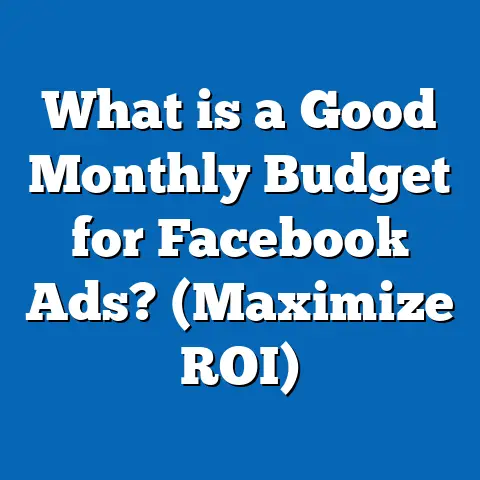What is a Native Facebook Ad? (Unlock Seamless Engagement)
What is a Native Facebook Ad? (Unlock Seamless Engagement)
Introduction: The Hidden Power of Native Advertising on Facebook
Picture this: You’re casually scrolling through your Facebook news feed during a quick break. You see posts from friends, updates from pages you follow, and some ads. But suddenly, one ad catches your eye—not because it’s flashy or intrusive, but because it feels like a natural part of your feed. It sparks your interest without pushing you away.
This subtlety is the magic of native Facebook ads.
In today’s digital world where users are bombarded by thousands of ads daily, catching attention is harder than ever. Traditional banner ads and pop-ups often get ignored or blocked. Users expect ads to be relevant but also non-disruptive to their experience. Native ads meet this expectation by blending content and promotion seamlessly.
This guide will take you deep into the concept of native Facebook ads, showing you how they work, why they matter, and how you can use them to drive meaningful engagement and business results. Whether you’re a marketing specialist or a business owner looking to improve your social media advertising ROI, this comprehensive walkthrough will equip you with the insights and practical knowledge to master native Facebook advertising.
Understanding Native Facebook Ads
Defining Native Facebook Ads
Native Facebook ads are advertisements that are designed to match the look, feel, and function of the platform’s natural content. Unlike traditional display ads that stand out with borders, flashing graphics, or pop-ups, native ads appear as part of the organic feed — they look like regular posts from friends or pages users follow.
This means:
- They use similar formats to organic posts (images, videos, text).
- They fit naturally into the user’s browsing experience.
- They do not interrupt the flow or feel intrusive.
Facebook defines these as “Sponsored” posts that are promoted to users beyond those who follow the page.
Why Facebook Is Ideal for Native Advertising
Facebook is not just a social network; it’s a digital ecosystem with more than 3 billion monthly active users worldwide as of early 2024. Users spend an average of 30 minutes daily on the platform. This massive scale combined with detailed user data creates a fertile ground for personalized native advertising.
Key advantages include:
- Massive Audience Reach: No other platform offers such broad demographic diversity.
- Advanced Targeting: Ability to target based on behavior, interests, location, device usage, and more.
- Multiple Ad Formats: Options like News Feed ads, Stories ads, Marketplace placements.
- Integrated Experience: Ads that don’t disrupt user experience but add value.
Types of Native Facebook Ads
Native ads on Facebook come in various forms:
1. News Feed Ads
The most common type. These ads appear directly in the user’s news feed and look like typical posts with images/videos and captions. They carry a small “Sponsored” label to indicate they’re paid content but otherwise mimic organic posts.
2. Stories Ads
Full-screen ads shown between user Stories that use vertical video or images designed for mobile viewing. They fit naturally into the Stories experience.
3. In-Stream Video Ads
Short video ads inserted into longer Facebook videos watched by users. These are similar to mid-roll ads on YouTube but are designed to be less intrusive.
4. Marketplace Ads
Ads integrated within Facebook’s Marketplace interface where users buy and sell items locally.
5. Suggested Video Ads
Ads appearing alongside recommended video content on Facebook Watch or Suggested Videos feed.
The Science Behind Native Facebook Ads: Why They Work
User Psychology and Ad Blindness
“Ad blindness” is a phenomenon where users unconsciously ignore banner-like advertisements due to overexposure. Research shows that 86% of internet users employ ad blockers or actively avoid traditional ads.
Native Facebook ads bypass this problem by:
- Blending with User Content: Making ads appear as part of the natural browsing flow.
- Improving Relevance: Targeting content that aligns with user interests.
- Reducing Intrusiveness: Avoiding disruptive formats like pop-ups or auto-play videos with sound.
Engagement Metrics That Matter
Data from multiple sources reveals significant engagement benefits for native Facebook ads:
| Metric | Native Ads Performance | Traditional Display Ads |
|---|---|---|
| Click-Through Rate (CTR) | 1.5% to 2.5% | 0.3% to 0.7% |
| Cost Per Click (CPC) | $0.50 – $1.20 | $1.00 – $2.50 |
| Conversion Rate | 4% – 6% | 2% – 3% |
| User Trust Increase | 70% (more likely to trust ad) | Lower |
Source: Nielsen, AdEspresso, Facebook Business reports
Relevance Score: The Algorithm’s Secret Weapon
Facebook assigns each ad a “Relevance Score” based on:
- How well the ad resonates with targeted users
- Engagement rates (likes, comments, shares)
- Feedback (negative feedback reduces score)
Higher relevance scores mean:
- Lower ad costs
- More impressions
- Better placement within feeds
Native ads typically earn higher relevance scores because they provide content users want rather than interrupting their experience.
Components of a Successful Native Facebook Ad
To create native ads that truly engage, focus on these components:
Visuals That Blend In but Stand Out
Use high-quality images or videos that look like typical user-generated content but are still visually appealing.
Tips:
- Use authentic photos rather than stock images.
- Videos should be short (15-30 seconds) and tell a story.
- Ensure mobile optimization with vertical formats for Stories and square/landscape for News Feed.
Copy That Speaks Like a Friend
Avoid hard selling or jargon-filled language.
Effective copy should:
- Be conversational and relatable
- Offer value or solve a problem
- Use storytelling to connect emotionally
- Include a subtle call-to-action (e.g., “Learn More”)
Call-to-Actions That Encourage Interaction Without Pressure
CTAs should invite users gently rather than push aggressively. Examples include:
- “Discover More”
- “Shop Now”
- “Sign Up Today”
- “Watch Video”
These encourage clicks without overwhelming the user.
Transparency: The Sponsored Label
Facebook requires all paid ads to have a “Sponsored” label to maintain transparency with users.
This helps build trust while ensuring compliance with policies.
Targeting Strategies for Native Facebook Ads
Targeting is where native advertising shines on Facebook due to its precise audience segmentation tools.
Core Audience Targeting
Filter by demographics such as:
- Age
- Gender
- Location (country, city, radius targeting)
- Language
This is useful for broad campaigns focused on specific groups.
Interest-Based Targeting
Target users based on their interests and behaviors such as:
- Pages liked
- Activities engaged in
- Purchase behaviors
- Device usage patterns
Example: A fitness brand targeting users interested in yoga and healthy eating.
Custom Audiences
Upload your own customer lists or retarget website visitors through pixel tracking.
Benefits:
- Reach warm audiences familiar with your brand.
- Increase conversion chances.
Lookalike Audiences
Create audiences similar to your best customers based on uploaded lists or pixel data.
This expands reach while maintaining relevance.
Deep Dive: Case Studies & Real-world Applications
Case Study 1: Eco-Friendly Apparel Brand Increases Sales via Facebook Native Ads
Background: Sustainable fashion company aiming to increase online sales with limited budget.
Strategy:
- Created native video ads featuring real customers discussing product benefits.
- Targeted eco-conscious millennials via interest-based targeting.
- Used Stories placements for mobile-first approach.
Results:
- 35% higher CTR than previous campaigns
- CPC reduced by 40%
- Conversion rate increased by 20%
- Return on ad spend (ROAS) of 4:1 within two months
Case Study 2: SaaS Provider Boosts Lead Generation Using Native Lead Ads
Background: B2B software company targeting mid-sized businesses.
Strategy:
- Deployed lead generation forms embedded in native Facebook ads.
- Used custom audience retargeting website visitors who downloaded whitepapers.
Results:
- Lead form completion rate improved by 30%
- Cost per lead dropped by $8 compared to LinkedIn campaigns
- Sales-qualified leads increased by 25%
Case Study 3: Local Restaurant Drives Foot Traffic with Marketplace Native Ads
Background: Regional restaurant chain targeting local customers.
Strategy:
- Created special offer promotions as native ads in Facebook Marketplace.
- Used geo-targeting within a 10-mile radius.
Results:
- Foot traffic increased by 15% during campaign period
- Redemption of digital coupons was tracked at 12%
Technical Concepts Explained Simply
How Does Facebook Deliver Native Ads?
Facebook uses an auction system where advertisers bid for ad placement. However, winning the auction doesn’t depend solely on money; relevance plays a huge role.
The process:
- Advertisers set a bid amount and target audience.
- Facebook’s algorithm calculates an estimated action rate (likelihood users will engage).
- A total value score combines bid amount and estimated engagement.
- Ads with highest total value are shown more often.
Native ads often win because their format drives higher engagement rates.
What is Ad Frequency?
Frequency refers to how many times an individual user sees your ad within a set period.
High frequency can lead to ad fatigue — users get annoyed seeing the same ad repeatedly—so it’s important to monitor and cap frequency in campaigns.
Pixel Tracking & Attribution in Native Ads
Facebook Pixel is code placed on your website that tracks user actions after clicking an ad.
It helps:
- Measure conversions
- Create custom audiences for retargeting
- Optimize campaigns based on real actions (purchases, sign-ups)
Attribution models assign credit for conversions to different touchpoints in the customer journey, helping you understand which native ads drive results most effectively.
Best Practices for Creating High-Converting Native Facebook Ads
1. Focus on Storytelling Over Selling
People engage more with stories than direct sales pitches. Frame your ad around a relatable problem solved by your product or service.
Example:
Instead of “Buy our running shoes now,” say “How Sarah improved her marathon time with our shoes.”
2. Use Authentic Visuals
Avoid overly polished stock photos. Use real images or videos showcasing genuine customer experiences or behind-the-scenes content.
3. Keep Text Concise and Impactful
Due to limited attention spans on social media:
- Headlines should be short (~5–8 words)
- Primary text should be clear and benefit-focused (~25–40 words)
4. Test Multiple Creatives Simultaneously
Use Facebook’s Dynamic Creative tool to test different images, headlines, descriptions, and CTAs automatically and optimize based on performance.
5. Leverage Social Proof
Include user testimonials, reviews, or metrics like “Join over 10,000 happy customers” to build trust within your native ad content.
Comparing Native Facebook Ads with Other Platforms’ Native Advertising
| Feature | Facebook Native Ads | Instagram Sponsored Posts | LinkedIn Native Ads | Twitter Promoted Tweets |
|---|---|---|---|---|
| Audience Size | Over 3 billion monthly active | Over 2 billion monthly active | Over 900 million professionals | Over 400 million monthly active |
| Main Content Types | Feed posts, Stories, videos | Feed posts, Stories | Feed posts, Sponsored InMail | Tweets |
| Best Use Cases | B2C and B2B | Visual-oriented brands | B2B lead generation | Real-time engagement |
| Targeting Depth | Highly granular; interests + behaviors + lookalikes | Similar targeting via Meta system | Professional targeting by job title/industry | Interest + demographic targeting |
| Average CTR | 1.5% – 2.5% | ~1.3% – 2% | ~0.5% – 1% | ~1% |
While Instagram shares Facebook’s backend targeting due to Meta ownership, LinkedIn excels in professional B2B targeting but at higher costs. Twitter offers immediacy but lower engagement rates on native formats compared to Facebook.
Advanced Techniques for Mastering Native Facebook Ads
Dynamic Creative Optimization (DCO)
DCO automates testing by mixing various creative elements (images, headlines, CTA buttons) into multiple versions and learning which combinations perform best in real-time. This reduces manual testing time and improves ROI.
Sequential Storytelling Campaigns
Use native ads in sequence to tell a story over several touchpoints—this nurtures leads gently by building interest step-by-step rather than pushing for immediate conversion.
Example sequence for an online course:
- Awareness (intro video)
- Consideration (testimonial/ad explaining benefits)
- Decision (special offer CTA)
Retargeting Warm Audiences With Personalized Content
Segment audiences based on past behavior — such as website visits or video views — then create native ads tailored specifically for these groups to increase conversions.
Incorporate User-generated Content (UGC)
Leveraging UGC in native ads boosts authenticity and trust since consumers trust peer recommendations more than brand messages.
Examples include customer photos, reviews turned into visuals or video testimonials embedded within native formats.
Measuring Success: Key Metrics for Native Facebook Ads
To evaluate your campaigns effectively track:
| Metric | Why It Matters |
|---|---|
| Click-through Rate (CTR) | Measures initial engagement |
| Conversion Rate | Tracks actual business outcomes |
| Cost per Click (CPC) | Helps manage budget efficiency |
| Cost per Acquisition (CPA) | Shows cost-effectiveness of driving sales/leads |
| Relevance Score | Indicates alignment with target audience |
| Engagement Rate | Likes, shares & comments reflect user interest |
Regularly review these metrics and adjust campaigns accordingly for continuous improvement.
Future Trends in Native Facebook Advertising
Increased Use of AI & Machine Learning
Facebook continues enhancing automated campaign management tools powered by AI:
- Better audience targeting predictions
- Smarter creative optimization
- Automated budget allocation across campaigns
Marketers should stay updated and leverage these tools for competitive advantage.
Interactive & Shoppable Native Ads
Facebook is testing interactive elements within native ads allowing direct shopping without leaving the platform—streamlining purchase journeys further and reducing friction.
Integration With Augmented Reality (AR)
AR experiences embedded in native ads offer immersive ways users can interact with products virtually — especially relevant for fashion, beauty, and home decor sectors.
Summary & Next Steps: Unlock Seamless Engagement With Native Facebook Ads
Native Facebook advertising offers a unique blend of subtlety and power—ads that feel natural yet drive compelling results. They earn higher engagement through relevance and seamless integration within the user’s feed experience.
To succeed:
- Understand different native ad formats on Facebook.
- Use precise targeting combined with authentic creative storytelling.
- Constantly analyze performance metrics like CTR, CPA, and relevance scores.
- Employ advanced strategies like dynamic creative optimization and retargeting.
- Stay ahead by embracing new features like shoppable ads and AR integration.
For marketing professionals and business owners eager to enhance their social media strategy, mastering native Facebook ads isn’t just an option—it’s essential for building authentic connections that convert into lasting growth.
If you want me to provide actionable templates or campaign checklists next, just let me know!

